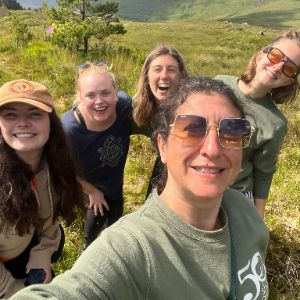Living La Vida Costa Rica
Jan 04, 2021First of all a very HAPPY NEW YEAR to you all!
I hope 2021 is kinder to all of us than 2020 has been...
As we all delve into New Year’s resolutions, I wanted to start my year talking about a country I admire and have followed the progress of for a few years now - Costa Rica.
This blog, is a little longer than my regular blogs because I found the story of the development of Costa Rica so interesting and inspiring that I couldn't make it any shorter!
The moral of the story for me, is that a government that invests in protecting its natural resources and educating its people on the importance of the same, is on a winning trajectory.
In the era of the world wide web and fake news, it is difficult to determine which “facts” are real or not so to write this blog I partnered with Luis Murillo from Costa Rica and I found the story of their sustainable developments fascinating.
Here is what Luis told me:
According to Luis, there were 4 elements of the history of Costa Rica that allowed them to develop the Sustainable Tourism landscape they enjoy today.
- The I.C.E. and the development of Clean Energy. During the 2nd Half of the XIX century, Costa Rica experienced an economic boom due to the sale of coffee. The government at the time gave away free land to families that wanted to develop coffee plantations. To this day, 80% of the coffee sold from Costa Rica comes from small family farms instead of large corporations. Their first big client was France and for nearly 50 years all their coffee was sold to France until other European countries discovered their amazing produce. Many sons and daughters of coffee farmers travelled to Europe with the coffee and apart from educating themselves, they brought back a lot of new socialist ideals from Europe.
In 1950, after the revolution, the new Social Republic of Costa Rica was born. The new constitution and president Rafael Calderon abolished the military and invested those resources in education, a health care system and forming the I.C.E. (Institute of Electricity) that provided electricity and telecommunications to the entire country. Most technicians in I.C.E. had been educated in Europe and they immediately decided to start obtaining energy from their rivers using hydroelectric energy. This made sense as it rains a lot in Costa Rica (I know another small country in Europe where it rains a lot!)
Some years later, I.C.E. started using geothermal energy from Costa Rica’s volcanoes. Fastrack to 2020 and remarkably 3 volcanoes are now producing geothermal energy for the country.
- The arrival of the Quakers to Monteverde. In 1950, around 50 families of Quakers (A religious society) from Ohio & Alabama arrived in Monteverde escaping the US military. They started producing milk and delicious cheeses, but their contribution to ‘green’ tourism was by chance at the start. They realised that Costa Rican farmers were overusing water and cutting down the rainforest. The Quakers got in touch with USA and Costa Rica universities to express their worry and a group of biologists founded the Tropical Science Center (T.S.C.). TSC educated local people about the importance of protecting the landscape and brought in many international professors and biologists to study the rainForest which was the very start of green tourism for Costa Rica.
- The C.C.C and Turtles. Biologist Acrhie Carr from the University of Florida, investigated turtles and found that all turtles from the Caribbean Sea come from one point in Costa Rica, including the famous green turtle. Archie founded the Association Friend of Turtles and a few years later the C.C.C. Caribbean Conservation Corporation to protect Turtles and increase green tourism inviting scholars and professors to investigate the green turtle origin. Over the years, green tourism grew with more and more people interested in the varied flora and fauna of this beautiful country and its rainforest.
- The National Parks. A tragedy occurred during 1970 & 1980, the burger boom! Can you imagine???? Latin America lost 40% of its tropical forest in order to produce meat for US burgers. Thanks to the pressure of the professors and universities worldwide to protect Costa Rica, the government decided to protect the rainforest that was still left. Towards the end of the 70’s, they had managed to protect 25% of the forest by creating National Parks, which was an example to Latin America and the entire world.
However, in the 1980, several political incidents changed tourism once again in Costa Rica. The 1st event was a civil war in Nicaragua, which frightened tourists and saw a decline in arrivals.
Also in the 1980’s an economic crisis saw a devaluation of their economy by 400%, which made it a very cheap country to visit compared to the USA $. This resulted in a “Boom” of their Green Tourism once again. Many small family businesses were created around the National Parks, with an emphasis on reuse and recycling of materials.
The 3rd change came when conservation agencies around the world like UICN, WWF and other ONGs started donating money to Costa Rica to help protect the land and to provide environmental education to local families.
Thanks to these donations, in the 1990s the government founded the National Forest Finance Fund, protecting the Forest in collaboration with other private entities that get paid to look after their land and protect it. Small tourism businesses were allowed to develop walks through the forest, building bridges with natural materials for the observation of flora and fauna, all under the umbrella protection of the NFFF.
Now in 2020, Green Tourism and the Tropical Forest produce more money for the Costa Rican economy than agriculture, and so people and the government have continued to increase the forest, which now takes up more than 50% of the country’s land
Since the year 2000, children in Costa Rica receive environmental education as part of their school curriculum, with the new generations adapting to the concept of conservation and protection from an early age.
Costa Rica has developed their own Sustainable Certification programmes for Tourism and Hospitality businesses, seeing businesses having waste management plans, reducing visitor numbers when needed to protect the landscapes, not using chemicals for cleaning or even in soaps and shampoos, etc.
Costa Rica is currently the front runner to achieve 100% renewable energy use, pretty soon I am guessing!! They are also the first country to eradicate single use plastics by 2021, their government does not mess about when it comes to sustainability, in Europe we hear these vague promises of SUP eradication in the next 10 years…blah, blah blah.
If you make a decision that single use plastics are bad for the planet, why wait 10 years????
It is very clear that investing on environmental education, supporting local communities and protecting natural resources have been 3 pillar of success for Costa Rica. Here in Europe, we are not even catching on yet to the amazing building blocks the Costa Rica’s government have put in place. Will we live to regret it?


